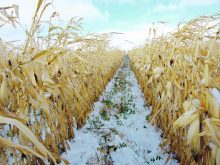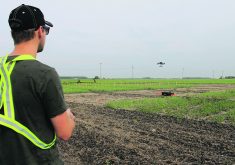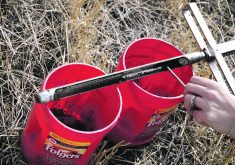The South East Research Farm continues its chickpea-flax work and is trying to determine the facts on humic acid
Glacier FarmMedia – The next round of trials and intercrop mixes are in the ground at the South East Research Farm in Redvers, Sask.
Lana Shaw, research manager at SERF, has a few projects she deems particularly noteworthy, among them tests of humic acid application with nitrogen fertilizer. Winter and spring camelina genetic mixes are also being explored.
There are root rot trials and work on chickpea-flax intercropping. That mix has gained attention due to an apparent reduction of disease pressure in the pulse.
Read Also

Alberta researcher helps unlock the economics of farming
Lethbridge Polytechnic researcher helping agriculture producers with decision-making tools in economic feasibility
Shaw said she is most interested in the trials with humic acid, which could change the game on fertilizer efficiency. Given the federal government’s goal to reduce nitrogen fertilizer emissions by 30 percent by the end of the decade, results will be interesting.
“If it works, it will be environmentally good, economically good for the farmers and it could be a win-win if it actually has merit in making the fertilizers more efficient,” Shaw said.
There are two hopeful outcomes: that nitrogen fertilizer will be less prone to gassing off and that fertilizer rates can be reduced.
Humic acid is a carbon-rich substance made of decomposed organic matter. Shaw described it as something between peat moss and coal, and it has potential as a nitrogen stabilizer. It is mainly mined in Alberta.
Many farmers have tried it but there’s no research to back up their findings, Shaw noted.
“It’s not been scientifically proven of what its real merits are as far as functionality. So, we’re trying it out as a nitrogen stabilizer in with liquid nitrogen or ammonium nitrate applications to see if that will help stabilize the nitrogen.”
Recent research from the University of Alberta is exploring the agronomy of Humalite, a humic product produced by WestMET Ag. It noted longer life in the soil for nitrogen, phosphorus and potassium, resulting in better yield and protein when tested on wheat, canola and peas.
Dealers of the product said they typically expect a delay in benefits, with increased yields realized in two to three years, one Manitoba dealer told Glacier FarmMedia.
Trials will occur at seven research sites across the province, all focusing on wheat and oats to compare quality and yield outcomes. The research is funded in part by the Sustainable Canadian Agricultural Partnership for a single year.
Shaw says good progress has been made on chickpea-flax intercropping trials. SERF has nine combinations this year, using three different flax and three different chickpea varieties. The goal is to identify the best combinations suited to intercropping.
“We don’t breed crops for suitability to intercropping. We breed them for performance as a stand-alone,” Shaw said. “So, this is the first trial that I know of where we’re focusing some on the varietal aspects for intercropping.”
The farm also continues work on the disease-dampening potential of the mix, which has consistently impressed in several years of study, according to Shaw. It initially garnered attention after trials noted the mix seemed to reduce chickpea ascochyta.
SERF might get better insight on that aspect this year, given a wetter spring. Recent drought years haven’t been great for disease research.
“This year, with it being wetter, we’re actually hoping that we can pick up differences,” Shaw said. “If you don’t have enough disease, you can’t find treatment effects or the effects of what you’re doing.”
Fungicide application is another project. Researchers plan to vary the number of applications across plots on intercropped and monocropped chickpeas to assess the effect of adding flax.
Camelina trials include a seeding date trial in both winter and spring varieties. Shaw said they’re comparing crop growth to determine if there may be dual-purpose genetics within the varieties.
SERF is also searching for a new companion crop to mix with caraway. The biennual crop is typically seeded alongside coriander, but disease makes this a problem.
“We’ve seeded it with peas, sunflowers, canaryseed and just a whole bunch of different kinds of grains, which will be harvested this fall,” said Shaw. “Then we’ll assess how the caraway is doing the next year, so that’s sort of a two-year intercrop.”
Root rot has become the most time-consuming trial. The farm is testing at least a dozen management approaches and products, such as gypsum and MustGrow.
“Some of them are more biological products or things like lime,” she said. “Some of them are seed treatments, where we have early and late seeding dates with and without seed treatments, and some are kind of agronomic approaches to managing root rot.
“We are blessed and cursed with quite a bit of root rot in the southeast area. We can do experiments to try to figure out what will help. But it’s not so good for the farmers. So, we’re working on it, but we haven’t found any magic bullets yet.”
















